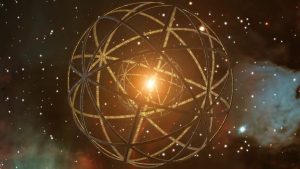Kardashev Scale Explained: Types of Civilizations and Their Energy Use

How do we measure the advancement of a civilization? The Kardashev Scale, proposed by astronomer Nikolai Kardashev, tackles this challenge in a fascinating and unique way.
Dive in as we explore and unravel the Kardashev Scale — a fascinating approach to measuring how advanced a civilization can become based on its energy mastery.
What is the Kardashev scale?
In 1964, Soviet astrophysicist Nikolai Kardashev introduced a method for classifying civilizations based on their energy consumption. This framework, now known as the Kardashev Scale, was initially proposed to aid the search for extraterrestrial intelligence by estimating what advanced civilizations might look like in terms of their energy use. Kardashev envisioned that as civilizations grow technologically, their energy demands increase proportionally. His scale remains a cornerstone of astrobiology and futurism, providing a fascinating lens through which to view humanity’s future potential.

Nikolai Kardashev
Nikolai Kardashev (1932–2019) was a pioneer in radio astronomy and space science, notably working on methods to detect signals from extraterrestrial sources. His interests lay at the intersection of cosmic phenomena and technological possibilities, leading him to imagine civilizations far more powerful than our own.
Type I Civilization: Mastery of a Planet

A Type I civilization is one that can utilize and store all of the energy available on its home planet. This includes energy from fossil fuels, nuclear power, geothermal sources, wind, and sunlight. Such a civilization would control weather systems, manage earthquakes, and tap into all planetary resources without exhausting them.
The internet along with other technological advancements, has brought humanity closer to achieving Type 1 civilization on the Kardashev Scale.
Achieving Type I status implies not only a technological revolution but also global cooperation and advanced sustainability practices. Energy output at this level is estimated to be around 10¹⁶ to 10¹⁷ watts, roughly the total amount of solar energy reaching Earth’s surface.
Fun Fact:
Famous theoretical physicist Michio Kaku often refers to a Type I civilization as a “planetary civilization,” likening it to a global society that speaks a common language, enjoys unified cultural exchanges, and has worldwide political structures.
Type II Civilization: Harnessing a Star

an artist impression of a Dyson Sphere around a star
A Type II civilization can control and harness the total energy output of its planet’s star. This is an extraordinary leap, involving technologies advancement far beyond our current understanding. Concepts like the Dyson Sphere—a hypothetical megastructure encompassing a star to capture its energy—emerge from this level of thinking.
The energy available at Type II would be approximately 10²⁶ watts, the full output of a typical star like our Sun. Civilizations at this level would colonize their entire solar system, manipulate planetary orbits, and possibly protect themselves against cosmic threats by moving entire worlds.
Trivia:
The idea of the Dyson Sphere was popularized by physicist Freeman Dyson, who theorized that a sufficiently advanced civilization would eventually need to build such structures to meet their growing energy needs.
Type III Civilization: Commanding a Galaxy

A Type III civilization would harness energy on the scale of its entire galaxy, drawing power from billions of stars. Such civilizations would likely be immortal, nearly indestructible, and possibly capable of manipulating the very fabric of space and time.
Energy consumption at this level is estimated at 10³⁶ watts. The scope of control could include the engineering of entire star systems, altering black holes, and perhaps traveling across galaxies. Observing a Type III civilization might involve detecting unnatural infrared emissions or unusual galactic structures.
Fun Fact:
Some scientists speculate that we might detect Type III civilizations by identifying “waste heat” — infrared radiation that could leak from their massive energy-collecting technologies.
Is Earth a Type I Civilization?
Currently, Earth is not classified as a Type I civilization. According to physicist Carl Sagan, who refined Kardashev’s ideas, humanity is approximately at 0.72 on the scale. This means we are utilizing a fraction of our planet’s total available energy.
To reach full Type I status, humanity must significantly increase renewable energy production, reduce reliance on finite resources, and develop robust global infrastructure. Current estimates suggest that, assuming continued technological and societal progress, we could achieve Type I status within the next 100 to 200 years.
Obstacles include geopolitical tensions, environmental degradation, and technological challenges. Nevertheless, the rapid acceleration of innovation in energy sectors—like solar, wind, and fusion research—offers hope that we are steadily moving toward this monumental milestone.
Trivia:
If humanity fully transitions to renewable energy and global cooperation, some futurists believe we could achieve Type I status as early as the late 22nd century.
Beyond the Kardashev Scale
While the original Kardashev Scale outlined three types of civilizations, later thinkers have proposed extensions:
- Type IV Civilization: A civilization that controls energy on the scale of an entire universe. This involves manipulating dark matter, dark energy, and possibly transcending physical laws as we know them.
- Type V Civilization: Often described in speculative fiction, this type would involve multiverse manipulation—commanding energies and realities beyond our own universe.
These extensions remain purely hypothetical and delve into realms far beyond current scientific comprehension. They serve less as concrete goals and more as imaginative prompts to explore the limits of human potential.
The Kardashev Scale, even six decades after its introduction, remains an inspiring roadmap for understanding what humanity might become. It challenges us to think not just about survival, but about thriving sustainably and ambitiously in a vast and energetic cosmos.

